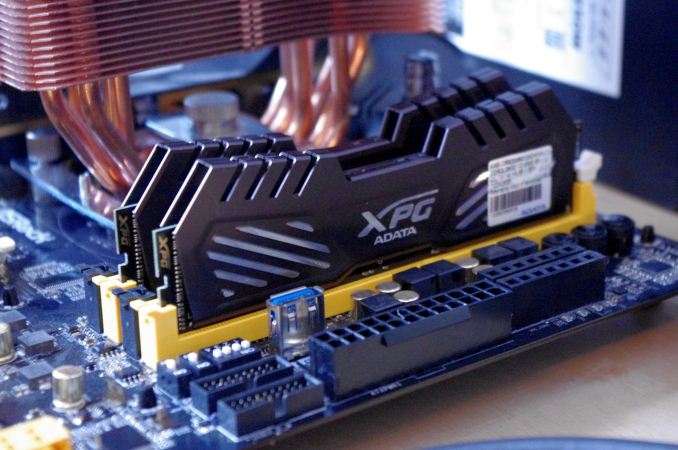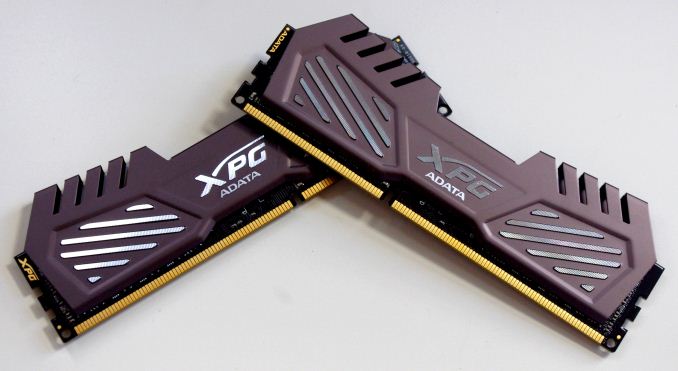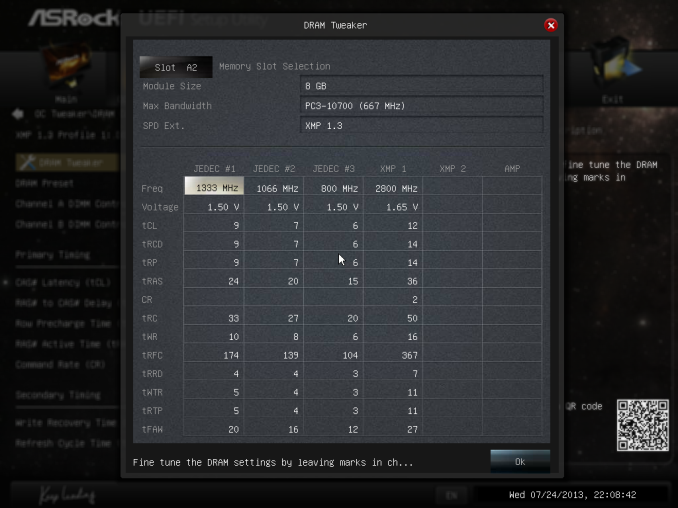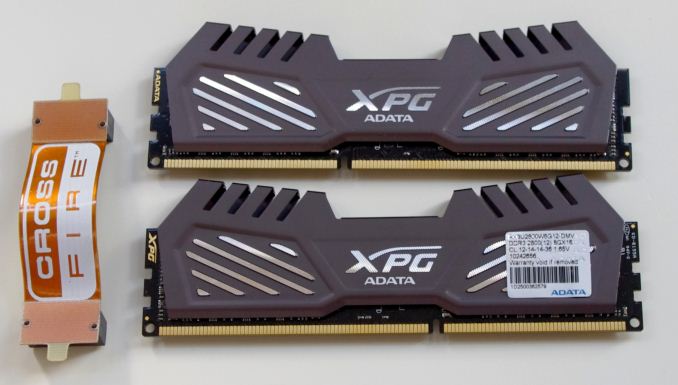ADATA XPG V2 Review: 2x8 GB at DDR3-2800 12-14-14 1.65 V
by Ian Cutress on December 17, 2013 12:00 PM EST
The final kit in our current run of DDR3 on Intel reviews falls at the feet of a kit that blends a high rated speed with density. When it comes to high MHz numbers, we typically see 4 GB modules as the standard, due to a higher density kit being more difficult to push in frequency. ADATA sampled us two of their DDR3-2800 C12 kits in 2x8 GB form, representing perhaps one of the final hurdles before DDR4 reaches the market, as long as your wallets are deep enough.
ADATA XPG V2: 2x8 GB at DDR3-2800 C12 1.65V Overview
I like to tell the situation how it is. Fast memory is always a thorny issue when it comes to reviewers, due to the propensity to give awards out like candy when in fact there is little to no performance gain – it all becomes about ego with regards owning the kit. For this reason, we tested a high end memory kit earlier this year in over 25 different configurations through 1333 MHz C9 to 3000 MHz C12 to find out where the law of limiting returns applies. The result of that was that 1866 C9 / 2133 C10 was the sweet spot, and anything over this had minute returns for most of our real world testing (we accepted that there are specific compute scenarios that do continually get a benefit).
So this means that the ADATA XPG V2 DDR3-2800 C12 kit we have in to review already starts off as a quest to brag about high performance memory. Using Hynix CFR ICs to push for frequency, ADATA took a slightly different route to most and decided on 8 GB modules rather than the standard 4 GB ones we see on the market. This means a match between high specification and high density memory: normally a very good thing in terms of developing an ecosystem, but only as far as the wallet can afford it.
The biggest drawback ADATA have with this memory kit is the price. When I started testing for this review, the AX3U2800W8G12-DMV kit was $600 – this has since risen to $646 due to the increase in memory pricing. That is a lot of money, no matter which way you cut it (it falls in the middle of two other kits of similar specifications): for similar pricing you could big up a 8x8GB kit of 2133 C9 of an X79 platform or save $100 and get 4x8GB of 2666 C11 for Z87. Pricing at the high end is monumentally crazy for what are specifications improvements rather than real world improvements. The only reason these kits cost so much is that the memory manufacturers bid on batches of CFR ICs, and the man hours required to test them – if only one memory stick in 1000 hits the required timings and voltages, that labor has to be paid for at some level.
Ultimately this is a 2x8GB kit with a Performance Index out of the box of 233, which was capable of ~240 when overclocked. Being 2800 C12, the kit does not fall into any of our benchmark pits that the low end kits fall into, but in the same breath it provides no direct advantage over any 2400 C10 kit which is substantially cheaper.
An unnamed source discussed with me this week the need for memory manufacturers to produce these high end kits, regardless of actual quantities sold, merely due to the fact that ‘everyone is doing it’ and a high MHz kit offers something in terms of marketing. But the result still stands: 2800 C12 (and up) does not benefit end users without a specific requirement for memory speed – I would perhaps even throw in 2666 to that mix as well. This may very well change with new games like BF4 (to be part of our 2014 testing), but at this point in our testing it makes little sense to look at high end kits other than excess cash burning a hole in your bank account.
Specifications
| ADATA | Corsair | Patriot | ADATA | G.Skill | ||
| Speed | 1600 | 2400 | 2400 | 2400 | 2800 | 3000 |
| ST | 9-11-9-27 | 11-13-13-35 | 10-12-12-31 | 10-12-12-31 | 12-14-14-36 | 12-14-14-35 |
| Price | £125 | $200 | - | $92 | $650 | $520 |
| XMP | Yes | Yes | Yes | Yes | Yes | Yes |
| Size | 2 x 8GB | 2 x 8GB | 2 x 8GB | 2 x 4GB | 2 x 8GB | 2 x 4GB |
|
Performance Index |
178 | 218 | 240 | 240 | 233 | 250 |
|
|
||||||
| MHz | 1600 | 2400 | 2400 | 2400 | 2800 | 3000 |
| Voltage | 1.35 V | 1.65 V | 1.65 V | 1.65 V | 1.65 V | 1.65 V |
| tCL | 9 | 11 | 10 | 10 | 12 | 12 |
| tRD | 11 | 13 | 13 | 12 | 14 | 14 |
| tRP | 9 | 13 | 13 | 12 | 14 | 14 |
| tRAS | 27 | 35 | 31 | 31 | 36 | 31 |
| tRC | 38 | 46 | 61 | 43 | 50 | 49 |
| tWR | 12 | 20 | 20 | 16 | 16 | 16 |
| tRRD | 280 | 315 | 315 | 301 | 367 | 391 |
| tRFC | 5 | 6 | 10 | 7 | 7 | 7 |
| tWTR | 6 | 10 | 10 | 10 | 11 | 12 |
| tRTP | 6 | 10 | 10 | 10 | 11 | 12 |
| tFAW | 24 | 33 | 46 | 26 | 27 | 29 |
| CR | - | 2 | 2 | 3 | 2 | 2 |
When using higher density memory, it is expected that some sub-timings will be slackened to ensure proper performance – ultimately the nearest kit we can compare it to is the 2400 C10 from Corsair, which had loose tRC and tRFC timings to begin with, which the ADATA beats despite being higher in MHz. Overall the ADATA 2800 C12 numbers are in line with what we expect.
Visual Inspection
Like the other ADATA memory reviews we have done over the past few months, the 2800 C12 $650 kit comes the same way as the rest – a simple plastic clamshell for easy removal. The memory kit itself is a Tungsten Silver/Grey, compared to the Gold styling we have seen previously.
The styling is exactly the same as the ADATA 2400 C11 kit we reviewed, giving an extra 13.8mm in z-height for a total height of 44mm.
ADATA gave us two kits to review, in a 2x8 GB and 4x8 GB configuration. It is worth noting that memory kits are never guaranteed to work together – they often need overclocking headroom or the CPU IMC needs to be able to cope with them. There are plenty of issues that can arise when memory kits do not work together, and the only way to ensure that four sticks of this memory run at the rated speed is to buy a four module kit.




















19 Comments
View All Comments
Khenglish - Tuesday, December 17, 2013 - link
Your tRFC and tRRD rows are flipped in the table on the first page.That tRFC is ridiculously high. Cut it by 150-200 in XTU (yes, by up to 200. It's that ridiculously high) and you'll see around a 500MB/s bandwidth improvement. For reference I've run 2133 CAS9 stable at tFRC 128 in a laptop.
Also it would be nice to see results on an IVB system as well as Haswell. IVB is just as good at the top end, but I've seen signs that haswell has a better IMC, so while this memory is stable on haswell, it might not be on IVB. Also most people still have an IVB or SB anyway.
Gen-An - Wednesday, December 18, 2013 - link
You can't cut the tRFC by much on these, they use 4Gbit Hynix H5TQ4G83MFR ICs, and especially not at the high clocks they're running. It's going to be over 200 at about any speed, and you pretty much have to run it at 396 or so for 2933.Hairs_ - Tuesday, December 17, 2013 - link
Can we please stop this series of articles now? please?jasonelmore - Tuesday, December 17, 2013 - link
yeah enough with the RAM reviews. we've been on DDR3 for almost 10 years,Jeffrey Bosboom - Tuesday, December 17, 2013 - link
The only explanation I can think of for all these RAM reviews is that in exchange for samples, Anandtech is obligated to provide brand exposure. Otherwise there'd just be one roundup saying "yeah, they're all about the same". If that's the case, I feel sorry for Ian, who surely has better things to do with his time.Navvie - Wednesday, December 18, 2013 - link
This is what I figured, the original article was quite interesting. But this is really scraping the bottom of the barrel for article ideas.DanNeely - Wednesday, December 18, 2013 - link
Gotta agree. At most this should be a twice a year round up; maybe only once yearly depending on how frequently binning changes switch out which clock/cl combinations offer the best bang for the buck.Gen-An - Wednesday, December 18, 2013 - link
Ian, you state these sticks are using Hynix CFR, but CFR is a 2Gbit IC, it'd be impossible to make an 8GB DIMM with them. This has to be Hynix 4Gbit MFR.ceomrman - Tuesday, December 31, 2013 - link
Hmmm... couldn't this article just say "premium RAM is a hoax. Just buy some decent sticks from a known brand with plenty of 4 or 5 Egg reviews, and go with 1866 MHz if your motherboard will support it. Go ahead and buy faster RAM, but don't spend much since the performance impact is not noticeable in the real world."There are zero users who would not benefit more from some other use of the money, either in their savings account or in the form of a bigger SSD, nicer motherboard, more efficient PSU, faster CPU, etc.
Dog + pony show = Blech.